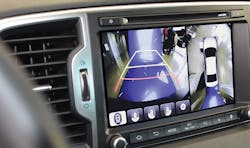Auto Transceivers Enable High-Definition Video via Basic UTP Cabling
In just a few years, the market and demand for real-time video streams in cars has gone from a single standard-definition (SD) image to multiple high-definition cameras. However, a challenging technical problem and practical production issue crops up when deploying multiple (or even one) HD sources: Each camera stream needs cabling, and this usually means coaxial cable or other shielded medium. What results are cabling and connector cost, bulk, weight, bend-radius and routing restrictions, and other issues in the already-cramped vehicle.
That dilemma should be avoidable with new transceivers (ADV7990 and ADV7991 transmitters; ADV7380 and ADV7381 receivers) developed by Analog Devices. The company’s proprietary Car Camera Bus (C2B) technology is embedded in the complementary transmitters and receivers, and allows use of low-cost, low-bulk, highly flexible unshielded-twisted-pair (UTP) cabling for high-definition video (see figure).
Using a unique cable-compensation design allows 30-meter cable runs with multiple in-line connections for resolution up to 2 Mpixels at 30 Hz, or 1 Mpixel at 60 Hz. Not only is the cabling itself lower cost and more agile, but the associated connectors are also smaller and less expensive compared to those of alternative cabling and link options.
The ADV799X transmitters and complementary ADV738X receivers from Analog Devices form a transceiver pairing that targets the rapidly growing use of video cameras in vehicles. They enable a high-definition video and control link using only basic unshielded-twisted-pair (UTP) cabling and connectors.
These transceivers, which feature negligible latency, deliver a 75-MHz pixel rate (75-MHz Y, 75-MHz C), while a bidirectional control function supports I2C, interrupt/status, and general-purpose I/O (GPIO), as well as “frozen frame” detection. As an added benefit, that bidirectional control channel uses the same UTP cable as the uncompressed HD video signal itself, so there’s no additional costs as would be needed if a separate control-channel path was required.
The C2B approach allows for up to 15 meters of cable with six inline connectors, and the receiver can function despite cable losses of up to 15 dB over the C2B bandwidth. Echo cancellation is also implemented to compensate for reflections introduced by impedance mismatch between cable and inline connectors or other impedance discontinuities.
For the ADV7990 transmitter, the supported parallel video input formats include 8-/10-/12-bit interleaved Y/C data up to 148.5 MHz; the ADV7991 transmitter adds 2 × 8-bit separate Y/C data up to 74.25 MHz. At the receiving side, the ADV7380 provides an HD output-video interface over a MIPI Camera Serial Interface 2 (CSI-2) transmitter, CSI-2 2-lane transmitter, or 1-lane transmitter running at up to 1 Gb/s per lane. And the ADV7381 supports parallel video output formats, including 8-bit and 10-bit interleaved Y/C data up to 148.5 MHz and 2 × 8-bit separate Y/C data up to 74.25 MHz.
Because the transceiver functions were defined and designed primarily for automotive applications, they’re in full compliance with the industry’s rigorous mandates for EMC, EMI, and ESD robustness. Electrical robustness is delivered via built-in protection from (and diagnosis of) high voltages that occur during short-to-battery (STB) fault conditions. Suitability for the automotive environment is enhanced by the −40 to +105°C temperature rating.
All of the transceiver ICs are sampling now. The 40-lead LFCSP ADV7991 transmitter ($4/1000-piece lots) and 48-lead LFCSP ADV7381 receiver ($6) will be in full production in November; the 32-LFCSP ADV7991 transmitter ($3.60) and 48-lead LFCSP ADV7380 ($6) are scheduled for January 2019 production.
About the Author

Bill Schweber
Contributing Editor
Bill Schweber is an electronics engineer who has written three textbooks on electronic communications systems, as well as hundreds of technical articles, opinion columns, and product features. In past roles, he worked as a technical website manager for multiple topic-specific sites for EE Times, as well as both the Executive Editor and Analog Editor at EDN.
At Analog Devices Inc., Bill was in marketing communications (public relations). As a result, he has been on both sides of the technical PR function, presenting company products, stories, and messages to the media and also as the recipient of these.
Prior to the MarCom role at Analog, Bill was associate editor of their respected technical journal and worked in their product marketing and applications engineering groups. Before those roles, he was at Instron Corp., doing hands-on analog- and power-circuit design and systems integration for materials-testing machine controls.
Bill has an MSEE (Univ. of Mass) and BSEE (Columbia Univ.), is a Registered Professional Engineer, and holds an Advanced Class amateur radio license. He has also planned, written, and presented online courses on a variety of engineering topics, including MOSFET basics, ADC selection, and driving LEDs.


